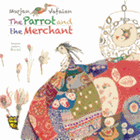
An avid collector, Persian merchant Mah Jahan's most precious possessions are her birds. Despite her devotion, "she kept them in cages or chains so that they couldn't fly away and leave her." Most beloved is "a beautiful bright parrot," favored because "the parrot had learned to talk." Preparing for her upcoming trading trip to India--the parrot's home--Mah Jahan asks the bird if she would like a gift. "Please say hello to my parrot friends in India," the bird responds. "Tell them that I miss them, and that makes me sad. Ask them if they have any advice for me."
After finishing her work, Mah Jahan visits the Indian jungle to share her parrot's message. The jungle parrots are initially silent, until one suddenly drops out of the sky. "Oh, how terrible, that parrot has just died!," Mah Jahan thinks before rushing away. Back at home, describing her experience to her parrot causes an eerily similar reaction... but the parrot's seemingly fatal response will be her salvation.
Award-winning Iranian artist Marjan Vafaeian daringly updates the revered 13th-century poet Rumi's familiar tale. Originally published in 2013 in Iran, then smoothly translated by Azita Rassi, Vafaeian's version assigns she/her pronouns to the merchant, inserting a subtle message about female agency, nonexistent 800 years ago. Beyond the often-adapted story (Rashin's Two Parrots is a recent example), Vafaeian's intriguing illustrations are especially noteworthy, described in an afterword as "a sophisticated mix of beautiful birds and fabrics with interestingly strange, almost sinister, human characters." The natural world is cause for colorful, gorgeous celebration, Vafaeian suggests, but human intrusion turns the narrative into a cautionary tale for uncertain times. --Terry Hong, Smithsonian BookDragon

